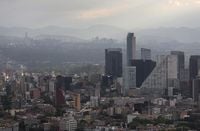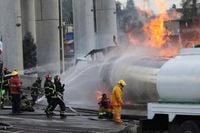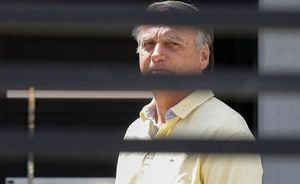On Wednesday, September 11, 2025, the bustling streets of southeastern Mexico City were rocked by a catastrophic explosion when a gas tanker truck overturned and erupted in flames beneath the Puente de la Concordia overpass in the Iztapalapa borough. The devastating blast killed at least three people and left 70 others injured, including a baby and a 2-year-old child, according to statements from Mexico City Mayor Clara Brugada and multiple reports from the Associated Press, Los Angeles Times, and Latin Times.
The tanker truck, reportedly carrying more than 49,500 liters (about 13,000 gallons) of gasoline or liquefied petroleum gas, was traveling along one of the capital’s busiest highways when it lost control, tipped over, and exploded in a massive fireball. The inferno incinerated nearly 30 vehicles, sent columns of black smoke billowing into the sky, and rattled buildings for blocks around. Flames several feet high could be seen from a distance, and the shockwave from the explosion shattered windows and sent debris flying across nearby neighborhoods.
“This is a horrible accident,” Mayor Brugada said at the site of the explosion, describing the scene as an “emergency” for the city. She confirmed that, as of Wednesday evening, three people had died and 70 had been injured, with 19 of the wounded listed in critical condition—including the truck driver and two young children. Among the injured, some suffered burns covering their entire bodies, with lists of victims indicating that several had up to 100% of their skin burned off. Emergency responders and neighbors worked together to pull burn victims from the wreckage, racing to get them to safety as medics and ambulances arrived on the scene.
Images and videos circulated widely on social media, showing the terrifying moment of the blast. In one clip, a motorist caught the exact instant the gas began leaking from the overturned tanker, quickly turning into a wall of fire that engulfed waiting cars at a traffic light. “People were running everywhere. Some jumped out of their cars to escape,” one witness told local media, recalling the chaos and panic as the explosion sent shockwaves across the area.
The explosion occurred shortly after 2:20 p.m., unleashing a series of secondary blasts that further escalated the crisis. The fireball damaged at least 18 vehicles and caused major traffic congestion along Calzada Ignacio Zaragoza and the Mexico–Puebla Highway, two vital arteries for the city. Eastbound lanes toward Puebla were reopened by early evening, but westbound lanes heading into the capital remained closed for cooling and cleanup operations. Motorists were advised to avoid the area as firefighters continued to douse the wreckage with water and foam, working to reduce the risk of additional explosions.
Emergency services responded in full force. The Mexico City Fire Department, supported by the State of Mexico Fire Department, the National Guard, the Navy, and local police, coordinated efforts to control the blaze and secure the perimeter. Ambulances from the Red Cross and the city’s Health Secretariat transported victims to a range of hospitals across Mexico City and neighboring municipalities. According to Mayor Brugada, 12 people were sent to the Juan Ramón de la Fuente Regional Hospital, nine to the Emiliano Zapata Extension Hospital, 15 to the Los Reyes La Paz Social Security Clinic, and another 15 to the ISSSTE Morelos Clinic. Additional patients were treated at the ISSSTE Zaragoza Hospital, the National Rehabilitation Institute, and Rubén Leñero Hospital.
As the flames were finally brought under control, the Mexico City Fire Department declared the fire completely extinguished. By nightfall, crews remained on site, continuing cooling operations and cleanup while police redirected traffic and secured the area to prevent further incidents. The roadway, one of the main routes out of the capital toward Puebla, was partially reopened by evening, though the memory of the disaster lingered for residents and commuters alike.
The tanker truck involved in the explosion bore the logo of the energy company Silza, but the company quickly denied ownership of the vehicle in a call with the Associated Press. Silza did not immediately respond to further requests for comment. Later that night, Mexico’s environmental ministry issued a statement revealing that Silza lacked the updated insurance paperwork required to transport gas, as its application had been rejected. This revelation raised serious questions about the regulatory oversight and safety protocols governing the transport of hazardous materials through densely populated urban areas.
Authorities wasted no time in promising a thorough investigation into the causes of the crash and explosion. Preliminary reports indicated that the tanker’s rollover triggered a rupture in its gas container, but investigators are examining whether mechanical failure, speeding, or human error played a role. Mayor Brugada praised first responders for their rapid and coordinated actions, stating, “We are coordinating all levels of government to guarantee attention to the victims and their families.” She also noted that the number of injured had risen throughout the afternoon as rescue and triage operations continued.
President Claudia Sheinbaum took to X (formerly Twitter) to express her condolences to the families of those who died and to thank emergency teams for their swift response. The president’s message echoed the sentiments of many Mexicans, who watched in horror as images of the burned vehicles and wounded victims—some with tattered clothing melted onto their skin—flooded news broadcasts and social media feeds.
For the people of Iztapalapa and the wider Mexico City region, the explosion was a grim reminder of the dangers posed by transporting hazardous materials on urban highways. The incident was the second major highway accident in Mexico that week, underscoring the urgent need for improved safety measures. As officials consider long-term steps to enhance road safety and regulatory compliance, the city’s focus remains on supporting the injured and their families and ensuring that such a tragedy does not happen again.
As night fell and the last embers were extinguished, the city began to take stock. The scars—both physical and emotional—will take time to heal. But amid the tragedy, the bravery of first responders and the solidarity of neighbors offered a glimmer of hope in the face of devastation.





